Bikes at the 2004 Paris-Roubaix: Part II
In part two of this special Cyclingnews technical feature, we take a look at what some riders did to...

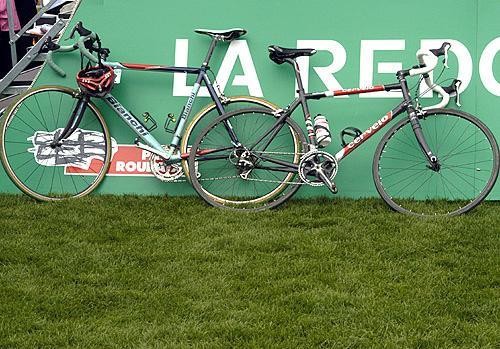
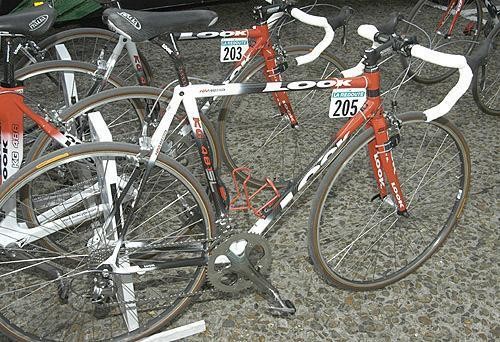
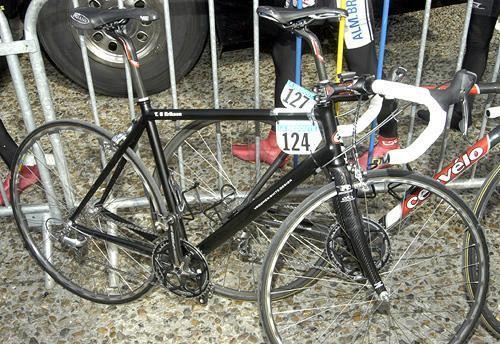
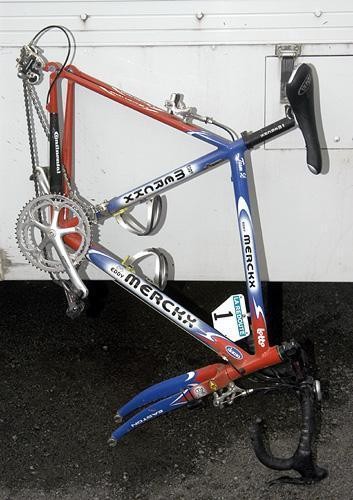
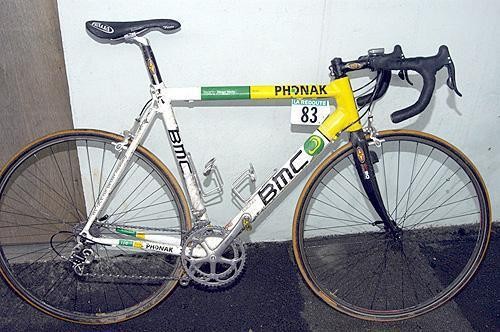








Tech feature - April 14, 2004
In part two of this special Cyclingnews technical feature, we take a look at what some riders did to their bikes before they tackled the "Hell of the North", and found out whether it was worth it.
Bikes at the 2004 Paris-Roubaix: Part I
One Giant leap: Stefen Wesemann's T-Mobile Team Giant TCR Composite Team
After ONCE pulled the plug in September last year, Taiwanese bike giant (sorry, pun intended) Giant Bicycles went looking elsewhere, scoring the right to kit out T-Mobile's squad of superstars that included 1997 Tour winner Jan Ullrich, Kazakh Alexandre Vinokourov and Stefen Wesemann, who made a giant leap forward in his career last weekend by claiming victory in the Ronde Van Vlaanderen.
Cyclingnews Tech Editor, John Stevenson, was fortunate enough to test a replica of the T-Mobile Giant a few weeks back, and boy, did he have fun. But what John also noticed was that Wesemann's Giant has specially-drilled brake bosses to accomodate cantilever brakes, and judging by the amount of clearance between the crown of the fork and the front tyre, he's substituted his road fork for a cyclo-cross fork. A all-carbon monocoque frame, the TCR Composite Team is one of the world's lightest production frames - if not the lightest - with a claimed weight of 950 grams for their medium-sized model. Strong box-section rims, 36 spoke wheels, some pavé-specific tyres, another helping of bar tape, and voila, Wesemann's steed was ready for Roubaix! Both the Giant and Wesemann held up well, but the 34 year-old German missed the winning move with around 12 kilometres to go and ended up in 16th place.
Podium placegetters - Magnus Bäckstedt's Alessio Bianchi and Tristan Hoffman's Team CSC Cervélo R2.5
Get The Leadout Newsletter
The latest race content, interviews, features, reviews and expert buying guides, direct to your inbox!
Could this be the first time in the race's history that Roubaix has been won on a titanium frame? Alessio was one of the only teams to equip their merry men with a machine specifically designed to tackle the pavé, and it looks like the extra attention to detail paid off for them. Cyclingnews diarist Scott Sunderland gave us a good run-down of Alessio's Bianchis specifically designed for the Hell of the North prior to the race, but did you read what he said afterwards? "As far as I know, we only had one puncture and that was Tafi's," said Scott.
That's really quite amazing, and while there's a degree of luck involved, it must surely say something about their choice of equipment. Added Sunderland: "We rode bigger tyres than a lot of teams with 24mm on the front and 28mm on the rear (Vittoria CG). It was a comfy ride I tell ya! They were as dull as anything on the asphalt, but on the cobbles they were really good. We had those radial spoked Nucleons (Campagnolo) and they were great. Also, I was really happy with the Bianchi titanium bike. It handled the pavé perfectly."
For those asking about a possible release date, we've got some good news: Stefano Viganò, Marketing and Communications Manager at Bianchi International HQ in Italy, tells Cyclingnews their titanium frames are welded on-site, and we can expect a special edition Ti model to be released next year to accompany their current XL Titanium SL frame. "Here at Bianchi, we weld our titanium tubes and we're seeing an increasing of demand for it. We well launch a special titanium frame into the next 2005 range," says Viganò.
An interesting tidbit comes from the bike of second-placed finisher, Tristan Hoffman. Cervélo's chief designer, Gerard Vroomen, tells Cyclingnews Hoffman started Roubaix on their aluminium R1 prototype that debuted at last weekend's RVV, but switched to his spare bike, the all-carbon R2.5, after suffering a mechanical (unrelated to the frame) before the town of Wallers. "He [Hoffman] said he was actually sad to get off the R1 even though he likes his R2.5. Strange guy," quips Vroomen.
Interesting, but not all that surprising: in the last 10 editions of Roubaix, five have been won on the carbon machines of Ernesto Colnago - Ballerini in '95 and '98, Museeuw in '96 and 2000, Tafi in '99 - and all on Colnago C-40s. Although not the same one, of course!
Look out world - Lilian Jegou's Credit Agricole Look KG 481 SL
Speaking of carbon, French manufacturer Look was one of the pioneers in the carbon-fibre revolution along with Colnago. Lilian Jegou's KG 481 SL is made from Promax Super SL high modulus carbon fibre (main triangle) and Carbon HM (rear triangle), using 7005 aluminum lugs to hold everything together. With a claimed weight of 1350 grams/2.9 pounds (frame only), the KG 481 SL would have been one of the lightest at Roubaix.
To keep things looking tidy, brake cables are internally routed and Look's Carbon HSC 4 SL integrated fork slots in ever so neatly up front. But other than some beefy Conti tyres and a double-serving of bar tape, that's about all the Credit Agricole mechanics did to make life easier on the pavé for 28 year-old Jegou, who didn't quite make it to the Roubaix velodrome last Sunday.
Young steed - Thomas Eriksen's Team CSC Cervélo R1
With seven riders in the top 50 and Tristan Hoffman's second place, Team CSC had a solid outing at the Hell of the North. 25 year-old Thomas Eriksen was the team's seventh-best finisher in 47th place, and being the youngest rider on their team for Roubaix, Eriksen most likely had little say in his choice of equipment.
As mentioned in Part I of Bikes at Roubaix, the R1 is an all-aluminium prototype based on identical design parameters to Hoffman's R2.5, and when released to the public (don't expect to see this anytime before 2005), the R1 will sit below their Cervélo's flagship carbon model.
Peter not-quite-perfect - Peter Van Petegem's Lotto-Domo Eddy Merckx Team SC
Last year's winner was looking like he could well do the Roubaix double until the Belgian punctured with less than 20 kilometres to go, finishing the race alongside his compatriot Johan Museeuw, who also suffered the same fate.
With Eddy Merckx's eponymous bikes kitting out the men from Lotto-Domo, it's suffice to say that these machines didn't need much tweaking before tackling cycling's most arduous one-day event. We took a closer look at the Team SC shortly after the Town Down Under, and came to the conclusion that these meticulously crafted machines from cycling's classics heartland resemble the type of riders they personify: solidly built, business-like, and will go the distance. While PVP's puncture was ill-timed, it wasn't really a case of equipment failure; it was just plain unlucky, as veterans of Roubaix - including Van Petegem - will tell you.
Talking in the Phonakular: Martin Elmiger's Phonak BMC
With a team pretty much entirely built around Tyler Hamilton and the 2004 Tour de France, no one was expecting great results from the Phonak Hearing Systems team. Martin Elmiger was their best-placed finisher in a very respectable 51st place, 13'19 off Magnus Bäckstedt's winning time of six hours, 40 minutes and 26 seconds, proving his Swiss-made BMC can just as easily handle the roads of Roubaix as the mountains of Le Tour.
Somewhat of a unique scenario, the world's third largest hearing aid company, Phonak, and BMC both share the same owner, which means that so long as there is a Team Phonak, the squad will ride and help develop BMC's framesets. Phonak has committed to their team through to 2007, so expect to see these visually distinctive frames that use what's known as "Crosslock Skeleton" technology for a few more years yet.
What's 200 grams between friends? Renaud Dion's R.A.G.T. Semences-MG Rover Look KX Light
Another Division I French team, R.A.G.T. Semences-MG Rover, also receive the pleasure of using Look's array of carbon frames and forks. Renaud Dion's Look KX Light isn't quite as light as Lilian Jegou's 1350 gram KG 481 SL mentioned above, but really, what's 200 grams between friends? Other notable differences include the use of semi-compact geometry, multi-shaped carbon fibre tubes and external cable routing. Again, another serve of bar tape and wider tyres was all that was done to make Dion's Look Roubaix-ready. Dion finished "The Hell" in 85th place, 31'09 down on winner Bäckstedt.